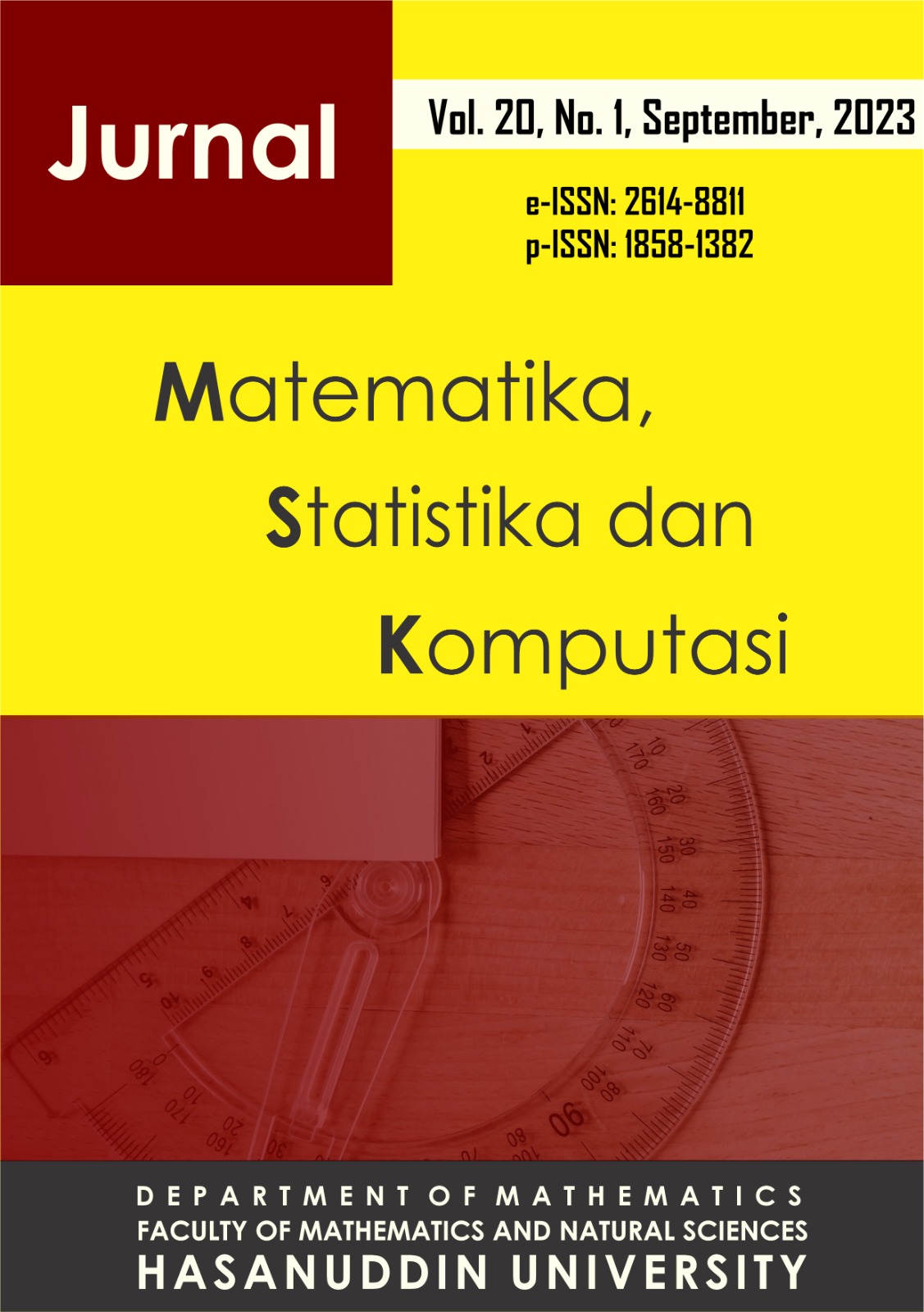Stability Analysis for the Spread of Mumps Based on SIQR Model
DOI:
https://doi.org/10.20956/j.v20i1.27060Keywords:
Mumps, SIQR, StabilityAbstract
Mumps is an infectious disease caused by a virus that is quite dangerous because vaccine strategies often fail. In severe cases, mumps can lead to infection of the covering of the brain (15%), pancreatitis (4%), permanent deafness, and painful swelling of the testes which rarely causes infertility. In addition, genetic mutations that are continuously carried out by the virus and the movement of individuals from one area to another can result in the spread of causing an epidemic in an area. This study discusses the spread of mumps by assuming there is a population of individuals who are quarantined. In addition, it is possible to die from mumps in the presence of complications from other diseases. The purpose of this research is to look at the behavior of the system solution analytically depending on the basic reproduction number ( ) accompanied by numerical simulations on initial values with certain parameters. The SIQR model is used by assumes that individuals who have recovered will get permanent immunity against Mumps. The analysis was carried out around the disease-free equilibrium point and the endemic equilibrium point. It was found that the disease-free equilibrium point is locally asymptotically stable with conditions . This means that if the birth rate is less than the natural death rate and the contact rate between individuals infected with mumps and susceptible individuals is less than the sum of the recovery rate, death rate and quarantine rate, then the mumps outbreak will eventually disappear from the population. On the other hand, the local asymptotically stable endemic equilibrium point if . This means that if the mumps disease is about to become epidemic and infected individuals are still in the population. This can be interpreted as if the birth rate is greater than the natural death rate and the contact rate between individuals infected with mumps and susceptible individuals is greater than the sum of the recovery rate, death rate and quarantine rate then the mumps outbreak will still exist in the population. However, if the value of the quarantine rate is increased, the value will decrease and the quarantined individual population approaches the infected individual population. This means that the proposed quarantine scenario with the addition of class Q makes the system solution better. Furthermore, a simulation was carried out with the Maple 18 program.
References
Chernov A., Kelbert M & Shemendyuk A., 2020, Optimal vaccine allocation during the mumps outbreak in two SIR centers, Mathematical Medicine and Biology: A Journal of the IMA, Vol. 37, Issue 3, 303–312.
Hakimeh M., Sunil K., Shahram R., Sina E., Side S., 2021, A theoretical study of the Caputo–Fabrizio fractional modeling for hearing loss due to Mumps virus with optimal control, Chaos, Solitons and Fractals, Vol 144, 1-13.
Jie. F. H., Ze. Y. Z., Wen. K. L. dkk., 2022, Correlation between mumps and meteorological factors in Xiamen City, China: A modelling study, Infectious Disease Modelling, Vol. 7, 127-137.
Kitano T., 2019, Dynamic transmission model of routine mumps vaccination in Japan, Epidemiology and Infection, 147, 1–8.
Nisar K S., Srinivas M N., Murthy B S N, Madhusudanan V., Gul N., Abdulrehman J & Zeb A., 2023, Exploring the dynamics of white noise and spatial temporal variations on hearing loss due to mumps virus, Results in Physics, 51, 106584.
Li Y., Liu X & Wang L., 2018, Modelling the Transmission Dynamics and Control of Mumps in Mainland China, International Journal of Environmental Research and Public Health, 15, 33.
Nurbek. A., Zhihang. P., Xinzhi. R., Yangjiang. W., Xianning. L., 2022, Vaccine failure, seasonality and demographic changes associate with mumps outbreaks in Jiangsu Province, China: Age-structured mathematical modelling study, Journal of Theoretical Biology, Vol. 544.
Pomeroy L W., Magsi S., McGill S & Wheeler C E., 2023, Mumps epidemic dynamics in the United States before vaccination (1923–1932), Epidemics, 44, 100700.
Qianqian. Q., Cong. F., Le. Z., Wanru. J., Jie. W., Yong. L., 2017, A mumps model with seasonality in China, Infectious Disease Modelling, Vol. 2, 1-11.
Senanayake, S. N., 2008, Mumps: A resurgent disease with protean manifestations. Medical Journal of Australia, 189, 456-459.
Wharton, I. P., Chaudhry, A. H., & French, M. E., 2006, A case of mumps epididymitis. Lancet, 367, 702.
Zhou L., Wang Y., Xiao Y., & Li M Y., 2019, Global dynamics of a discrete age-structured SIR epidemic model with applications to measles vaccination strategies, Mathematical Biosciences, 308, 27-37.
Downloads
Published
How to Cite
Issue
Section
License
Copyright (c) 2023 Author and publisher

This work is licensed under a Creative Commons Attribution 4.0 International License.

This work is licensed under a Creative Commons Attribution 4.0 International License.
Jurnal Matematika, Statistika dan Komputasi is an Open Access journal, all articles are distributed under the terms of the Creative Commons Attribution License, allowing third parties to copy and redistribute the material in any medium or format, transform, and build upon the material, provided the original work is properly cited and states its license. This license allows authors and readers to use all articles, data sets, graphics and appendices in data mining applications, search engines, web sites, blogs and other platforms by providing appropriate reference.







